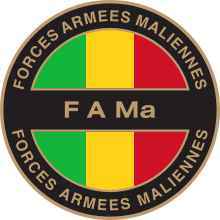
Back القوات المسلحة المالية Arabic Forces armées maliennes German Armitaj Fortoj de Malio Esperanto Fuerzas Armadas de Mali Spanish Mali sõjavägi Estonian Malin asevoimat Finnish Forces armées maliennes French הכוחות המזוינים של מאלי HE Mali hadereje Hungarian Angkatan Bersenjata Mali ID
This article has an unclear citation style. (December 2019) |
| Malian Armed Forces | |
|---|---|
| Forces Armées Maliennes | |
 | |
| Founded | 10 October 1960[1][2][3] |
| Service branches | Malian Army Malian Air Force Malian Gendarmerie Republican Guard National Police (Sûreté Nationale) |
| Headquarters | Bamako |
| Website | fama |
| Leadership | |
| Commander-in-chief | Assimi Goïta |
| Minister of Defence | Sadio Camara |
| Chief of General Staff | Oumar Diarra |
| Personnel | |
| Conscription | Compulsory military service[4] |
| Active personnel | 40,000 plus 4,800 paramilitary forces |
| Expenditure | |
| Budget | $200–300 million ($5 million procurement) (FY03) |
| Percent of GDP | 3% (FY01) |
| Industry | |
| Foreign suppliers | |
| Related articles | |
| Ranks | Military ranks of Mali |
The Malian Armed Forces (French: Forces Armées Maliennes) consists of the Army (French: Armée de Terre), Republic of Mali Air Force (French: Force Aérienne de la République du Mali), and National Guard.[7] They number some 7,000 and are under the control of the Minister of Armed Forces and Veterans. The Library of Congress as of January 2005 stated that "[t]he military is underpaid, poorly equipped, and in need of rationalization. Its organisation has suffered from the incorporation of Tuareg irregular forces into the regular military following a 1992 agreement between the government and Tuareg rebel forces."[8]
In 2009, the IISS Military Balance listed 7,350 soldiers in the Army, 400 in the Air Force, and 50 in the Navy.[9] The Gendarmerie and local police forces (under the Ministry of Interior and Security) maintain internal security. The IISS listed paramilitary total force as 4,800 personnel: 1,800 in the Gendarmerie (8 companies), 2,000 in the Republican Guard, and 1,000 police officers. A few Malians receive military training in the United States, France, and Germany.
Military expenditures total about 13% of the national budget. Mali is an active contributor to peacekeeping forces in West and Central Africa; the Library of Congress said that in 2004 Mali was participating in United Nations operations in the Democratic Republic of Congo (MONUC, 28 personnel including 27 observers), Liberia (UNMIL, 252 personnel, including 4 observers), and Sierra Leone (3 observers).
- ^ DISCOURS DE AMADOU TOUMANI TOURE, PRESIDENT DE LA REPUBLIQUE, : CINQUANTENAIRE DU 20 JANVIER Archived 22 July 2011 at the Wayback Machine (Speech by Amadou Toumani Touré, President of the Republic Demi-Centennial of 20 January), primature.gov.ml, 20 January 2011. The President of Mali's Demi-Centennial Army Day speech, with a detailed history of the formation of the Malian Armed Forces and withdrawal of French forces.
- ^ 49EME ANNIVERSAIRE DU 20 JANVIER Archived 22 July 2011 at the Wayback Machine, Discours de Amadou Toumani TOURE, Président de la République,(49th Anniversary of 20 January, speech by Amadou Toumani Touré, President of the Republic of Mali), primature.gov.ml, 20 January 2010. The President of Mali on the History of the Malian Armed forces.
- ^ Fete de l'armee: Beintot un demi siecle. Archived 22 July 2011 at the Wayback Machine S. Konate. L’Essor n°16365, 2009-01-19. Reprinted on primature.gov.ml.
- ^ Financial Times, World Desk Reference Mali Defense Archived 10 February 2012 at the Wayback Machine
- ^ a b c d e f "Trade Registers". Armstrade.sipri.org. Archived from the original on 14 April 2010. Retrieved 6 January 2019.
- ^ "Mali Gets Warplanes From Russia, Drones From Turkey". The Defense Post. 15 March 2023. Archived from the original on 31 July 2023. Retrieved 31 July 2023.
- ^ "The World Factbook". Central Intelligence Agency. United States Federal Government. 12 January 2017. Archived from the original on 30 March 2021. Retrieved 20 January 2017.
- ^ Library of Congress, Country Profile Archived 5 April 2015 at the Wayback Machine, January 2005
- ^ IISS Military Balance 2009 p.310